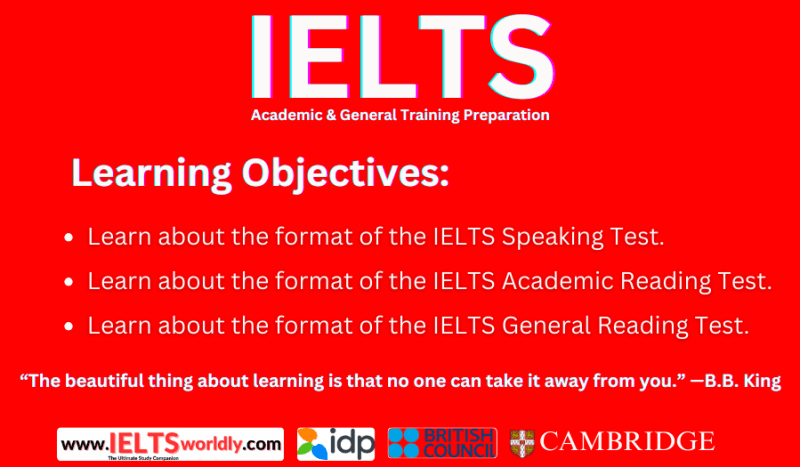Learn IELTS Academic and General Training Reading and Speaking Test Format with free Practice Test and PDF.

The IELTS Speaking test is a face-to-face interview with a certified examiner and consists of three parts. The test lasts between 11 to 14 minutes.
Part 1: Introduction and Interview (4-5 minutes)
- Content: The examiner introduces themselves and confirms the candidate’s identity. The examiner then asks general questions about familiar topics such as home, family, work, studies, and interests.
- Purpose: To assess the candidate’s ability to provide information about themselves and talk about everyday topics.
Speaking Part 2: Long Turn (3-4 minutes)
- Content: The candidate is given a task card with a topic and has one minute to prepare. During this time, they can make notes. The candidate then speaks for 1-2 minutes on the topic without interruption. After the candidate finishes, the examiner may ask one or two follow-up questions.
- Purpose: To assess the candidate’s ability to speak at length on a given topic, use appropriate language, and organize their thoughts coherently.
Part 3: Discussion (4-5 minutes)
- Content: The examiner and the candidate engage in a discussion on more abstract ideas and issues related to the topic in Part 2. This part of the test involves more complex questions and requires the candidate to express and justify opinions, analyze, discuss, and speculate about issues.
- Purpose: To assess the candidate’s ability to discuss abstract ideas and concepts, express and justify opinions, and use complex language.
Throughout the Speaking test, the examiner evaluates the candidate’s performance based on four criteria:
- Fluency and Coherence: The ability to speak at length with natural continuity, use cohesive devices, and maintain coherent speech.
- Lexical Resource: The range and accuracy of vocabulary used, including the ability to paraphrase and use idiomatic language.
- Grammatical Range and Accuracy: The range and accuracy of grammatical structures used, including sentence complexity and error frequency.
- Pronunciation: The ability to produce clear and understandable speech, including stress, rhythm, and intonation.
The IELTS Reading test has different formats for the Academic and General Training versions, but both versions consist of 40 questions and must be completed in 60 minutes.
Academic Reading
- Content: Three long reading passages taken from books, journals, magazines, and newspapers. These texts are written for a non-specialist audience and are academic in nature.
- Types of Questions: Multiple choice, identifying information (True/False/Not Given), identifying the writer’s views/claims (Yes/No/Not Given), matching information, matching headings, matching features, matching sentence endings, sentence completion, summary completion, note completion, table completion, flow-chart completion, diagram label completion, and short-answer questions.
General Training Reading
- Content: Three sections with increasing difficulty.
- Section 1: Two or three short factual texts related to everyday life (e.g., notices, advertisements, timetables).
- Section 2: Two texts related to work (e.g., job descriptions, contracts, training materials).
- Section 3: One longer, more complex text on a general topic.
- Types of Questions: Similar to the Academic test, including multiple choice, identifying information (True/False/Not Given), identifying the writer’s views/claims (Yes/No/Not Given), matching information, matching headings, matching features, matching sentence endings, sentence completion, summary completion, note completion, table completion, flow-chart completion, diagram label completion, and short-answer questions.
Both versions of the Reading test assess a range of reading skills, including reading for gist, reading for main ideas, reading for detail, skimming, understanding logical arguments, and recognizing writers’ opinions, attitudes, and purpose.


